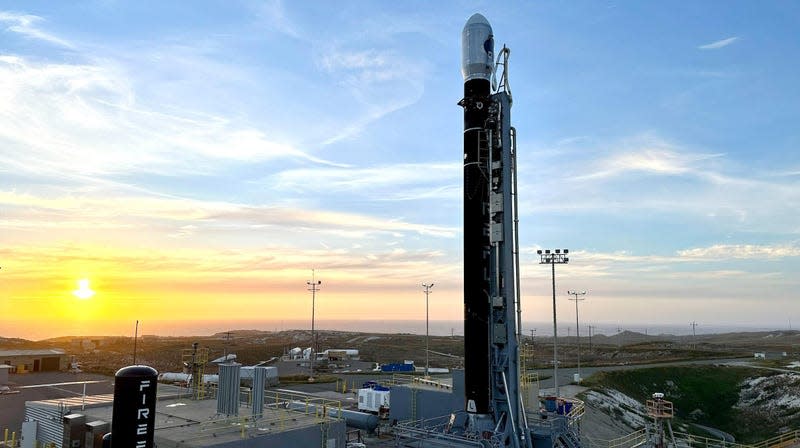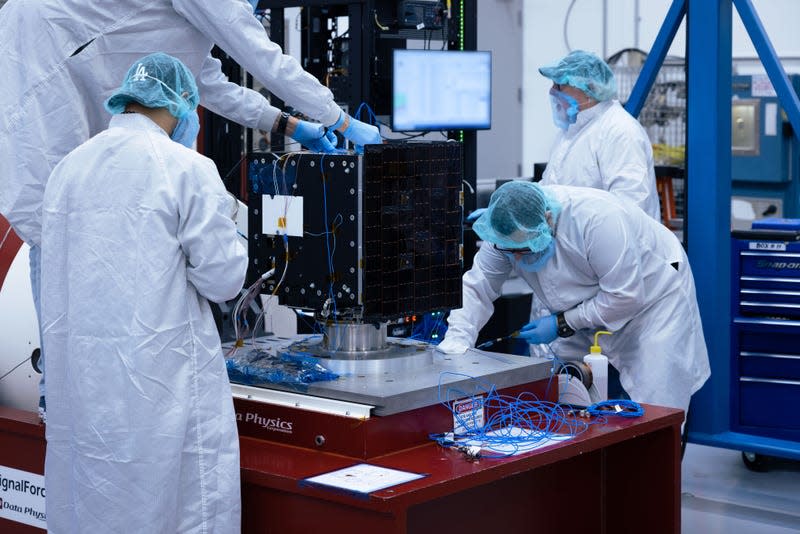Victus Nox: What to Know About Space Force's Rapid-Launch Satellite Mission

What happens when a satellite gets destroyed in orbit? Typically, weeks, months, or even years of planning and logistics precede the launch of a replacement. However, Space Force has hatched a plan to ambitiously cut that time down to a mere 24 hours, and the latest test of that plan could happen any minute.
According to the Space Force FAQ, the newest military branch exists to organize, train, and equip space forces “in order to protect U.S. and allied interests in space and to provide space capabilities to the joint force.” Key to these goals is the acquisition of military space assets, but the potential for U.S. adversaries to knock out these assets has Space Force thinking about a concept known as “tactically responsive space.”
Read more
What is “tactically responsive space”?
As early as 2005, the Armed Forces of the United States began discussing tactically responsive space, then referred to as “operationally responsive space.” The idea was predicated on the possibility that, in times of war or some similar national emergency, satellites in orbit could be damaged or destroyed. In that time of crisis, replacing the faulty equipment quickly would be paramount for the U.S. military to maintain its foothold in space. The concept is seemingly a topic of interest for the Department of Defense as both Russia and China are reportedly amping up their offensive capabilities in space.
In 2019, the conversation around tactically responsive space continued, as the Pentagon announced that it would be pursuing satellite launches with a 24 hour turnaround time. Two years later, Congress tasked the Department of Defense with developing the capability. Democrat Representative Adam Smith from Washington, then chairman of the House Armed Services Committee, reportedly asked the Department of Defense to submit a plan for rapid launch turnarounds as part of the National Defense Authorization Act.
Related: Space Force Wants $60 Million for Ultra-Quick Satellite Launches
This past March, Space Force officially submitted a budget to Congress asking for $60 million for tactically responsive space—this marked the first time the Defense Department’s budget had specifically requested funding for this initiative. Earlier funding came from congressional add-ons, but here, the DoD asked for $30 million in the 2024 fiscal year and another $30 million in the 2025 fiscal year.
What is Victus Nox?
Victus Nox, Latin for “conquer the night,” is an upcoming mission to demonstrate how Space Force, and contractors Firefly Aerospace and Millennium Space Systems, might actually be able to achieve this tactical capability. The Victus Nox mission will challenge Space Force, Firefly, and Millennium Space to launch a spacecraft into orbit within a mere 24-hour window after receiving the go-ahead.
Launch update: Our next launch, FLTA003, will support the @SpaceForceDoD responsive space mission, VICTUS NOX. We’re in the final integration of our Alpha rocket and will soon stand ready for the 24-hour call-up. We’re honored to work with this incredible team! #PartnersInSpace pic.twitter.com/Sch7LUX8mm
— Firefly Aerospace (@Firefly_Space) March 20, 2023
In 2021, Space Force first demonstrated its rapid response capabilities during its Tactically Responsive Launch-2 mission, in which a Northrop Grumman Pegasus XL rocket flew to space. According to Space Force’s own account, the mission occurred on June 13, 2021 and saw Northrop Grumman launching the rocket from Stargazer, a modified Lockheed L-1011 aircraft. After taking off from Vandenberg Space Force Base, Stargazer reached 40,000 feet (12 kilometers) above the Pacific Ocean and launched Pegasus, which carried a demonstration satellite into orbit.
The second rapid response demonstration will be Victus Nox, formally known as Tactically Responsive Launch-3, and unlike the previous mission, Space Force wants a rocket to launch directly from the ground and deliver its payload to space. In October 2022, both Firefly and Millennium Space officially announced that they had joined the Victus Nox mission; Firefly won a contract worth $17.6 million while Millennium’s contract was for an unspecified amount. Firefly will provide the rocket and Millennium will provide the satellite.
Related: Firefly Sends Alpha Rocket to Orbit, One Year After Explosive Launch Attempt
“The U.S. Space Force’s vision to quickly launch an asset in response to dynamic changes in space is a critical capability for our national security,” said Firefly Aerospace CEO Bill Weber in a statement emailed to Gizmodo. “The importance of this mission for the Space Force and our country has been one of the motivating factors for our team to rapidly innovate, test, integrate, and stand ready for the 24-hour call up.”
When will Victus Nox launch?
Details of the mission are scant, and that’s on purpose, as Space Force wants the two contractors to treat Victus Nox like it’s the real deal. That said, both Firefly and Millennium Space were able to describe the basic plan to Gizmodo.
Dana Carroll from Millennium Space told Gizmodo in an email that the contractors are approaching the Hot Standby Phase, during which Space Force could call on them to begin launch preparations on Victus Nox. When Millennium Space Systems gets the go-ahead from Space Force, the company will have 60 hours to transport a satellite over 170 miles (274 kilometers) from the company’s factory in El Segundo, California, to Vandenberg Space Force Base. The satellite is about the size of a mini-fridge, and while the company would not reveal the specifics of its size or what equipment it will carry, Carroll did tell Gizmodo that it’s a piece of equipment pulled right off the company’s own production line.

“Everything about this mission is exciting and challenging, from the rapid eight-month delivery of a satellite to the activation phases,” Carroll told Gizmodo in an email. “We have a small team dedicated to Victus Nox. Sixty hours is not a lot of time so you need to have the right people on hand that understand truly any discrepancy and can disposition it immediately.”
After Millennium Space Systems delivers the satellite to Vandenberg, a six month window begins, during which both companies will get a call to launch the satellite within 24 hours using Firefly’s Alpha rocket. Firefly spokesperson Risa Schnautz told Gizmodo via email that the company’s Alpha rocket is ready and waiting at Vandenberg for Millennium’s satellite, and that Firefly completed construction of a cleanroom to prepare the satellite for launch. The company is conducting dry runs in preparation for adding the payload to the rocket, and on April 12, the company completed a static fire test of the rocket, according to Schnautz.
“We’re now completing the final readiness milestones for the build-up phase before we enter the stand-by phase and wait for activation,” Schautz told Gizmodo. “Firefly’s rapid-assembly manufacturing capabilities across the organization allows the team to accelerate Alpha production and support on-demand launch timelines.”
Until then, we must all wait in anticipation. While Victus Nox is serving as a blueprint for bolstering national security from the threat of a damaged or destroyed satellite, the applications of a successful demonstration of tactically responsive space could pave the way for compressed launch windows in both private and publicly funded space agencies.
For more spaceflight in your life, follow us on Twitter and bookmark Gizmodo’s dedicated Spaceflight page.
More from Gizmodo
Sign up for Gizmodo's Newsletter. For the latest news, Facebook, Twitter and Instagram.

